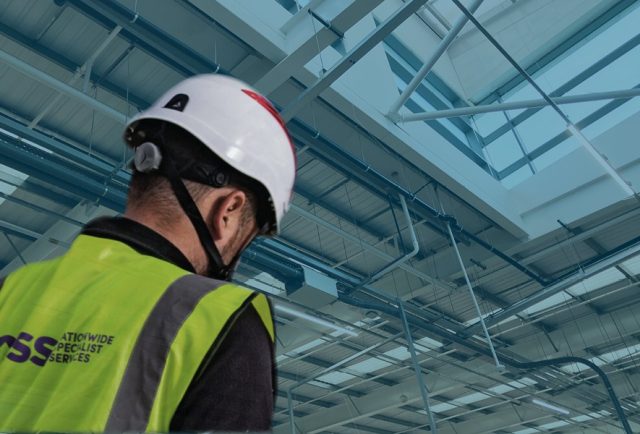When the Heavens Open, Will Your Roof Cope?
The videos of Manchester’s flooded streets during last year’s thunderstorms tell a sobering story. Commercial properties across the UK are increasingly vulnerable to sudden, intense rainfall events that can overwhelm drainage systems in minutes.
At NSS, we’re seeing it firsthand on callouts – businesses forced to close areas, valuable stock is damaged, and operations disrupted after heavy downpours breach roofing systems. And these aren’t necessarily poorly maintained buildings. Many simply weren’t designed to handle the intensity of rainfall we’re now experiencing across the UK.
Recent data confirms what we’re seeing on the ground: 2024 saw rainfall volumes 40-60% higher than the 1991-2020 averages across all regions.
The British Standards Institution has responded with the publication of BS 8490:2025 in February this year, introducing critical changes to siphonic drainage standards. If you own or manage commercial buildings, here are the five things you absolutely need to know about these new standards:
1. Most Existing Buildings Are No Longer Compliant
The most significant change in BS 8490:2025 concerns internal gutters. Previously, secondary systems were only required for certain difficult layouts. Now, the standard explicitly states that “where systems can block and cause ingress to buildings, a Primary & Secondary should be provided.”
What this means for you: If your building has internal gutters with only a primary siphonic system, it no longer meets current standards—regardless of whether it satisfies rainfall flow rate requirements. This affects the vast majority of commercial buildings constructed before 2025.
2. Climate Change Is Driving These Changes
The new standards directly respond to changing weather patterns. With each degree of global warming, the atmosphere holds approximately 7% more moisture, resulting in more intense rainfall when conditions are right.
What this means for you: These aren’t arbitrary regulatory changes—they reflect the new reality of our climate. The systems that adequately protected buildings in the past are increasingly likely to be overwhelmed by today’s more intense storms.
3. Not All Roof Types Require Updates
While the new standards significantly impact buildings with internal gutters, they don’t apply uniformly to all roof types. Flat sealed roofs (membrane/felt) and outboard eave gutters are exempt from the secondary system requirement.
What this means for you: Understanding your specific roof configuration is crucial to determining your compliance requirements. A professional assessment can identify exactly which portions of your drainage systems need upgrading.
4. There Are Serious Financial Implications for Non-Compliance
Beyond the direct risk of water damage, non-compliance with current standards could affect your insurance coverage. Insurers are increasingly scrutinising flood risk management measures during policy renewals.
What this means for you: The cost of implementing secondary siphonic systems is typically far less than the potential losses from a significant water ingress event, especially when you consider business interruption, inventory damage, and potential increases in insurance premiums.
5. Retrofitting Can Be Done with Minimal Disruption
Upgrading to compliant systems doesn’t necessarily mean major disruption to your business operations. Modern installation techniques allow for secondary systems to be added with minimal impact on day-to-day activities.
What this means for you: With the right specialist contractor, you can achieve compliance without shutting down operations. The work can often be phased to manage capital expenditure while prioritising the most vulnerable areas.
Real-World Impact
Billy Gordon, Technical Manager at NSS, shares a recent experience: “One of our clients, a major retailer, experienced significant water ingress at their North West store during summer 2023 when their primary-only system was overwhelmed during an intense rainfall event. The flooding resulted in damaged stock, closed trading areas, and disappointed customers.
“After implementing a secondary siphonic system to complement their existing primary system, they weathered several comparable storms in 2024 without issue. This real-world validation of the secondary system’s effectiveness convinced them to accelerate their upgrade programme across all their properties.”
Don’t Wait for a Crisis
If your building was constructed before February 2025, there’s a high likelihood that your siphonic drainage system no longer meets current standards. Rather than waiting for a major rainfall event to expose vulnerabilities, we recommend taking proactive steps now:
- Schedule a professional assessment of your current drainage systems
- Understand your specific compliance requirements based on your roof configuration
- Develop a phased implementation plan if upgrading is necessary
- Review insurance policies to understand any compliance implications
- Update maintenance protocols to meet the enhanced requirements in the new standard
NSS is a nationwide specialist in maintenance, cleaning, hire, and testing services, delivering comprehensive solutions for commercial properties across the UK. As members of the Siphonic Roof Drainage Association with over 50 years of collective industry experience, our in-house team of NICEIC-approved technicians brings unparalleled expertise to every project. Operating with our own fleet of vehicle-mounted access platforms, we provide both planned maintenance and rapid emergency response without relying on subcontractors.
Whether you need roof maintenance, siphonic drainage upgrades, or specialist cleaning services, NSS is committed to protecting your business operations with dependable service that sets new standards for safety, speed, and transparency. Contact us today to learn how we can help safeguard your property and reputation.

